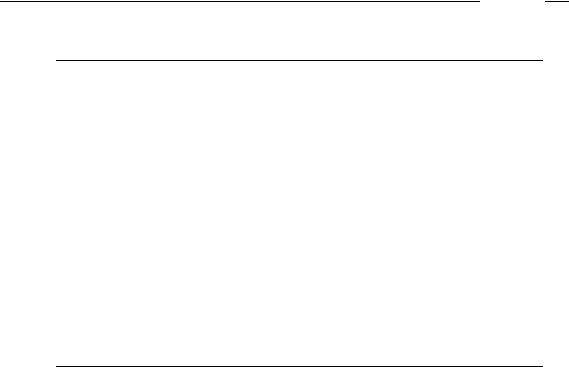
Modern Banking
.pdf
[ 118 ]
M O D E R N B A N K I N G
depending upon whether interest rates rise or fall. For example, prepayment risk arises with fixed rate mortgages. A prepayment18 option will result in different outcomes; if interest rates rise, mortgage prepayments decline and the expected average life of the portfolio increases. On the other hand, if rates fall, prepayment increases (because the fixed payments are less attractive) and the average life of the portfolio declines. In some countries (e.g. the UK), the borrower is charged a penalty for early repayment of a mortgage. In others, such as the USA, there is no penalty charge on prepayment of mortgages.
3.3.2. Gap Analysis
Gap analysis is the most well known ALM technique, normally used to manage interest rate risk, though it can also be used in liquidity risk management. The ‘‘gap’’ is the difference between interest sensitive assets and liabilities for a given time interval, say six months. In gap analysis, each of the bank’s asset and liability categories is classified according to the date the asset or liability is repriced, and ‘‘time buckets’’: groupings of assets or liabilities are placed in the buckets, normally overnight– 3 months, >3 – 6 months, >6 –12 months, and so on.
Analysts compute incremental and cumulative gap results. An incremental gap is defined as earning assets less funding sources in each time bucket; cumulative gaps are the cumulative subtotals of the incremental gaps. If total earning assets must equal total funding sources, then by definition, the incremental gaps must always total zero and therefore, the last cumulative gap must be zero. Analysts focus on the cumulative gaps for the different time frames. The above points are demonstrated in a simplified interest rate ladder, in Table 3.3.
Table 3.3 separates the assets and liabilities of a bank’s balance sheet into groups with cash flows that are either sensitive or insensitive to changes in interest rates. An asset or liability is said to be interest rate sensitive if cash flows from the asset or liability change in the same direction as a change in interest rates. The ‘‘gap’’ (see Table 3.3) is the sterling amount by which rate sensitive assets (RSA) > rate sensitive liabilities (RSL). A negative gap means RSA < RSL; a positive gap means RSA > RSL. The gap ratio is defined as RSA/RSL. If the gap ratio is one, then the rate sensitivity of assets and liabilities is matched, and the sterling gap is zero.
Most banks have a positive gap, that is, rate sensitive assets exceed rate sensitive liabilities, because most banks borrow long and lend short, so their assets will mature later than their liabilities. For example, a bank will have rate sensitive deposits, which can be withdrawn any time, but the majority of its rate sensitive loans are not due to be paid back anywhere from a year up to 25 years in the case of a mortgage.
Suppose a bank has a positive gap (RSA > RSL). Then a rise in interest rates will cause a bank to have asset returns rising faster than the cost of liabilities, but if interest rates fall, liability costs will rise faster than asset returns.
18 Prepayment refers to the repayment of the principal and any outstanding interest on a loan before the maturity date. For example, fixed rate mortgages may be repaid early because interest rates decline and the mortgagee wants to get a better rate, or because the circumstances of the borrower change: they move house or need to refinance the loan.

[ 119 ]
M A N A G E M E N T O F R I S K S I N B A N K I N G
Table 3.3 Gap Analysis for Interest Rate Risk (£m)
|
|
Overnight–3 |
>3–6 |
>6–12 |
>1–2 |
>2–5 |
5 years or |
|
|
months |
months |
months |
years |
years |
not stateda |
|
|
|
|
|
|
|
|
Earning Assets |
|
|
|
|
|
|
|
Notes & coins |
£5 |
|
|
|
|
|
|
3-Month bills |
£5 |
|
|
|
|
|
|
Interbank loans |
£20 |
|
|
|
|
|
|
5-Year bonds |
|
|
|
|
|
|
|
Overdrafts |
|
|
£20 |
|
|
|
|
5-Year loans |
|
|
|
|
|
£20 |
|
Property |
|
|
|
|
|
|
£30 |
Funding Sources |
(−£100) |
|
(−£50) |
(−£45) |
|
|
|
Retail and term |
|
|
|
||||
deposits |
|
|
|
|
|
|
|
3-Month wholesale |
(£5) |
|
|
|
|
|
|
deposits |
|
|
|
|
(−£10) |
|
|
Capital |
|
|
|
(−£50) |
|
|
|
Net mismatch gap |
£15 |
£20 |
(−£55) |
£20 |
£30 |
||
Cumulative |
b |
0 |
(−£35) |
(−£55) |
(−£5) |
£50 |
£30 |
mismatch gap |
|
|
|
|
|
|
|
a Not stated normally includes a bank’s equity because there is no maturity associated with the bank stock. b Cumulative mismatch: cumulated/summed from long to short.
Defining E as the equity value or net worth of the bank, then
E = A − L
E = A − L
where:
E: change in the net worth of the bankA: change in the value of assets
L: change in the value of liabilities
On this banking book, if the maturity of its assets exceeds the maturity of its liabilities, then a parallel rise in all interest rates will reduce the market values of both assets and liabilities of the bank. However, the value of the assets will fall by more because they mature later than the bank’s liabilities. The term maturity gap is used to emphasise the point that it is the difference in maturity that is affecting both sides of a bank’s balance sheet.
The assets and liabilities on the banking book, as illustrated in Table 3.3, can also be summarised with a formula for a maturity gap:
Maturity gap = WARSA − WLRSL

[ 120 ]
M O D E R N B A N K I N G
where:
WA: weighted average of rate sensitive assets WL: weighted average of rate sensitive liabilities
The bigger the maturity gap, the more a bank’s net worth will be affected by a change in interest rates. Suppose the bank wants to immunise itself, i.e. hedge against this type of interest rate risk. If it structures the banking book such that the weighted average of RSA equals the weighted average of RSL, so MA − ML = 0, then it will substantially reduce, but not eliminate, interest rate risk on the banking book. The bank is not fully hedged against; it ignores the following.
žThe extent to which a bank is geared or leveraged, that is, the extent to which loans are funded by deposits (as opposed to equity).
žDuration – to be discussed below.
The maturity gap analysis presented above provides the ALM group with a picture of overall balance sheet mismatches. While this type of analysis still takes place in most banks, it is used in conjunction with other risk management tools, for a number of reasons.
1.Mismatches that fall within each time bucket are ignored. Returning to the case study examples, suppose the deposit product had a term of 3.5 months, so that it was repriced after this time. The loan will not be repriced until after six months, making the >3 – 6 month time bucket liability sensitive, though in the gap analysis it appears to be asset sensitive, because the loan was £1012, funded by a £1000 deposit and £100 in equity; equity is in the ‘‘not stated’’ time bucket because it has no stated maturity.
2.Interest rates on deposit accounts, some loans and credit card receivables are not solely determined by the market interest rates. Some banks offer ‘‘free’’ bank services with a current account but compensate for it by paying a lower rate.
3.It ignores the bank’s exposure to prepayment risk, the risk that long-term fixed rate mortgages and loans will be repaid early if interest rates fall.
4.Some bank products, such as non-maturity accounts, non-market rate accounts and off-balance sheet items, cannot be handled in a gap analysis framework, though part of this problem has been overcome through duration gap analysis (see below).
3.3.3. Duration Analysis
Duration analysis expands on the gap analysis presented above by taking duration into account. Again, the objective is to consider the impact on shareholders’ equity if a risk-free rate, for all maturities, rises or falls, but takes the procedure one step further. Duration analysis allows for the possibility that the average life (duration) of an asset or liability differs from their respective maturities. Suppose the maturity of a loan is six months and the bank opts to match this asset with a six-month CD. If part of the loan is repaid each month, then the duration of the loan will differ from its maturity. For the CD, duration is identical

[ 121 ]
M A N A G E M E N T O F R I S K S I N B A N K I N G
to maturity if depositors are paid a lump sum at the end of the six months. However, if only part of the loan is repaid each month, and depositors are paid a lump sum, a duration gap is created, exposing the bank to interest rate risk.
Duration is the present value weighted average term to repricing, and was originally applied to bonds with coupons, correcting for the impurity of a bond: true duration is less than the bond’s term to maturity. The duration of an ‘‘impure’’ bond (that is, one with a coupon) is expressed as follows:
Duration = T{1 − [coupon size/(MV × r)]} + [(1 + r)/r][1 − (DPVR/MV)] (3.1)
where:
T: time to redemption
r: market (nominal) interest rate MV: market value
DPVR: discounted present value of redemption
For example, suppose the problem is to compute the duration of a 10-year £100.00 bond with a fixed £5.00 coupon. The coupon is paid annually, the first one at the end of the first year of the investment, and the last one at the time the bond is redeemed. The current market price for the bond is obtained by computing the present value, using the formula
(c/r)[1 − (1 + r)−T] + RT(1 + r)−T |
(3.2) |
where:
c: coupon value (£5.00)
r: market interest rate, with a horizontal term structure, assumed to be 10% T: date of redemption
RT: amount redeemed (£100.00)
In the example, the current market price of the bond is:
£100(1.1)−10 + £50[1 − (1.1)−10] = £50[1 + (1.1)−10] = £69.277
There is a cash flow associated with the bond, and the idea is to discount each cash flow to the present value. To compute the duration, the formula from equation (3.1) is used:
Duration = 10[1 − (£5/£6.9277)] + (1.1/0.1){1 − [£100(1.1)−10/£69.277]}
= 7.661 years19
As can be seen from the example, duration analysis emphasises market value, as opposed to book value in gap analysis. All cash flows are included in the computation, and there is no need to choose a time frame, unlike gap analysis.
19 As opposed to a 10 year maturity.

[ 122 ]
M O D E R N B A N K I N G
Duration analysis has been widened to include other assets and liabilities on a bank’s balance sheet with flexible interest rates, and paid by borrowers or to depositors at some point in the future. In these cases, the duration of the equity is computed as:
DE = [(MVA × DA) − (MVL/DL)] ÷ (MVA − MVL) |
(3.3) |
where:
DE: duration of equity
DA: duration of rate sensitive assets DL: duration of rate sensitive liabilities MVA: market value of asset
MVL: market value of liability
The computed duration of equity is used to analyse the effect of a change in interest rates on the value of the bank, because it will approximate a zero coupon bond with the given duration.20 The greater a bank’s duration mismatch, the greater the exposure of the bank to unexpected changes in interest rates.
3.3.4. Duration Gap Analysis
Duration gap analysis estimates a bank’s overall interest rate exposure on the balance sheet, taking into account that duration gaps are present. The key question is, in the presence of a duration gap, how is the value of shareholders equity affected for a given change in interest rates?
The duration of the assets and liabilities are matched, instead of matching time until repricing, as in standard gap analysis. The onand off-balance sheet interest sensitive positions of the bank are placed in time bands, based on the maturity of the instrument. The position in each time band is netted, and the net position is weighted by an estimate of its duration, where duration measures the price sensitivity of fixed rate instruments with different maturities to changes in interest rates. If the duration of designated deposits and liabilities are matched, then the duration gap on that part of the balance sheet is zero. This part of the balance sheet is said to be immunised against unexpected changes in the interest rate. In this way, immunisation can be used to obtain a fixed yield for a certain period of time because both sides of the balance sheet are protected from interest rate risk. Note, however, that the protection is less than 100%, because market yields can change in the middle of an investment period, and other risks are still present, such as credit risk. Furthermore, the duration measure used assumes a linear relationship between interest rates and asset value. In fact the relationship is normally convex. The greater the convexity of the interest rate – asset value relationship, the less useful is the simple duration measure.
20 Another way of interpreting duration is that it shows how sensitive the value of assets and liabilities are to changes in interest rates, i.e. it measures the interest elasticity of the value of an asset or liability. Saunders derives an algebraic formula showing the link between duration and interest sensitivity of an asset (or liability). See Saunders (2002), ch. 9. His work, in turn, is based on Kaufman (1984).

[ 123 ]
M A N A G E M E N T O F R I S K S I N B A N K I N G
Hence, the use of duration to measure interest rate sensitivity should be limited to small changes in the interest rate.
Saunders (2002)21 shows how a duration model can be used to measure the overall gap of the bank’s exposure to interest rate risk, i.e. the duration gap. Begin by summing up the bank’s duration of, respectively, its assets and liabilities portfolio.
DA: the market value weighted average of the individual durations of each asset in the portfolio
DL: the market value weighted average of the individual durations of each liability
E = A − L |
(3.4) |
where:
E: the change in net worth of the bank
A: the change in market value of assets for a given change in interest ratesL: the change in market value of liabilities for a given change in interest rates
Saunders (2002, pp. 208 –211) shows the net worth of the bank can be expressed as:
E = −(adjusted duration gap) × asset size × interest rate shock
where
interest rate shock = R/(1 + R)
where R is the yield to maturity, and will change, for example, as a result of a change in the interest rate set by the central bank:
adjusted duration gap = duration gap DA − GDL
where DL is adjusted for the proportion of assets funded by liabilities (e.g. deposits, or other borrowed funds) rather than equity. That is, DL is adjusted for gearing or leverage: G = L/A, where A is total assets and L is the bank’s liabilities, excluding equity.
Thus:
E = −[DA − GDL] × A × R/(1 + R) |
(3.5) |
Example:
Assume DA = 4 years and DL = 2 years.
Assets on the balance sheet are £200 million; liabilities consist of £150 million of borrowed funds and £50 million of equity. So L/A = 150/200 = 0.75 and GDL = (0.75)(2) = 1.5.
Suppose the bank expects interest rates to rise by 0.5% from 5% to 5.5%. ThenR = 0.005 and (1 + R) = 1.05, so R/(1 + R) = 0.00476.
21 Saunder’s work, in turn, is based on Kaufman (1984).

[ 124 ]
M O D E R N B A N K I N G
So E = −(4 − 1.5) × £200 000 000 × 0.00476 = −£2 380 000 or − £2.4 million. Thus, as a result of an increase in interest rates, the net worth of equity holders will fall
by £2.4 million.
The Basel Committee (see Chapter 4) recommends that banks using the standardised approach for market risk also adopt this method for monitoring their interest rate exposure.
3.3.5. Liquidity Risk and Asset–Liability Management
The ALM group in a traditional bank is also responsible for the management of liquidity risk. As defined earlier, it is the risk that a bank is unable to meet its liabilities when they fall due. Liquidity risk is normally associated with the liabilities side of the balance sheet when depositors unexpectedly withdraw their financial claims. Assuming the liquidity preferences of a bank’s customers are roughly constant, the problem usually arises if there is a run on the bank as depositors try to withdraw their cash. A bank liquidity crisis is normally triggered either by a loss of confidence in the bank or because of poor management practices, or the bank is a victim of a loss of confidence in the financial system, caused, possibly, by the failure of another bank. Contagion and systemic risk are discussed in detail in the next chapter. However, if the bank experiences an unusually high deposit withdrawal rate, and lacks the cash or is unable to borrow the money quickly, it is faced with liquidating its longer-term investments, possibly in a market where other banks and investment houses are also selling, pushing down prices.
A bank can also experience liquidity problems on the asset side of the balance sheet, caused by large numbers of unexpected loan defaults. Banks have also been caught out granting credit lines which they do not expect to be drawn down, but which are subsequently used by the borrowers. If an economy goes into recession relatively quickly, these banks may see firms drawing down their credit lines all at once, which will put pressure on their liquidity. There is also liquidity risk linked to off-balance sheet transactions, and to a slow-down or collapse in the payments system.
If a bank does experience liquidity problems, the central bank is usually willing to lend to them at some penal rate, which is costly for the bank. Also, the central bank will have to be reasonably certain that the problem is one of illiquidity and not insolvency. Banks will borrow funds on the interbank markets or from other sources before they approach the central bank, but again, this is costly for the bank, and undermines its profitability.
The objective of liquidity risk management should be to avoid a situation where the net liquid assets are negative. Gap analysis can be used to manage this type of risk. The gap is defined in terms of net liquid assets: the difference between net liquid assets and volatile liabilities. Liquidity gap analysis is similar to the maturity ladder for interest rate risk, but items from the balance sheet are placed on a ladder according to the expected time the cash flow (which may be an outflow or an inflow) is generated. Net mismatched positions are accumulated through time to produce a cumulative net mismatch position. The bank can monitor the amount of cash which will become available over time, without having to liquidate assets early, at penal rates.

|
|
|
|
|
[ |
125 ] |
|
|
|
|
|
|
|
|
|||
|
|
M A N A G E M E N T O F R I S K S I N B A N K I N G |
||||||
|
Table 3.4 Liquidity Funding – Maturity Ladder Approach (£000) |
|
|
|
|
|
||
|
|
Week 1 |
Week 2 |
Week 3 |
Week 4 |
|||
|
|
|
|
|
|
|
|
|
|
Cash inflows |
12 000 |
10 000 |
10 000 |
|
8 500 |
|
|
|
Assets (week they mature) |
1 500 |
8 000 |
2 000 |
|
1 000 |
|
|
|
Sales planned |
10 000 |
1 000 |
3 000 |
|
2 500 |
|
|
|
Agreed credit lines |
500 |
1 000 |
5 000 |
|
6 000 |
|
|
|
Cash outflows |
11 700 |
9 500 |
10 700 |
|
8 900 |
|
|
|
Liabilities due |
7 000 |
3 000 |
9 000 |
|
4 000 |
|
|
|
Contingent liabilities (e.g. credit lines) |
4 500 |
6 000 |
1 500 |
|
4 500 |
|
|
|
Unplanned cash outflows |
200 |
500 |
200 |
|
400 |
|
|
|
Net funding needs |
−300 |
−500 |
700 |
|
400 |
|
|
|
Cumulative net funding needs |
−300 |
−800 |
−100 |
300 |
|
|
|
It is assumed that each week is 5 working days, and all sums are received on the last working day of each week (Fridays).
The Bank of International Settlements (2000) has outlined a maturity ladder approach, which consists of monitoring all cash inflows and outflows, and computing the net funds required. A simple version of this type of ladder appears in Table 3.4.
The ALM group in a bank is not normally responsible for risk management in other areas, though how risk management is organised does vary from bank to bank. In some banks, the ALM group has been replaced by a division with overall responsibility for risk management, but credit risk continues to be managed separately. Increasingly, 21st century banks have a division with overall responsibility for coordinating risk management.
The management of interest rate risk has moved beyond the traditional gap and duration analysis because banks have increased their off-balance sheet business and the use of derivatives. Derivatives were discussed briefly in Chapter 2, but the next section provides a more detailed coverage of derivatives and their role in risk management.
3.4. Financial Derivatives and Risk Management
3.4.1. Types of Financial Derivative
Before looking at how banks manage credit and market risk, this section considers the role of financial derivatives in risk management, because they are part of a bank’s tool kit for managing risk. Derivatives were touched upon briefly in Chapter 2, which provided some basic definitions and noted the rapid growth in the derivatives market after 1980.
Financial Derivatives (or derivatives for short) are instruments that allow financial risks to be traded directly because each derivative is linked to a specific instrument or indicator (e.g. a stock market index) or commodity.22 The derivative is a contract which gives one party a claim on an underlying asset (e.g. a bond, commodity, currency, equity) or cash value of the asset, at some fixed date in the future. The other party is bound by the contract
22 From Gray and Place (1999), p. 40.

[ 126 ]
M O D E R N B A N K I N G
to meet the corresponding liability. A derivative is said to be a contingent instrument because its value will depend on the future performance of the underlying asset. The traded derivatives that are sold in well-established markets give both parties more flexibility than the exchange of the underlying asset or commodity.
Consider the case of the pig farmer who knows that in six months’ time s/he will have a quantity of pork bellies to sell. The farmer wishes to hedge against the fluctuation in pork belly prices over this period. He/she can do so by selling (going short) a six-month ‘‘future’’ in pork bellies. The future will consist of a standard amount of pork bellies, to be exchanged in six months’ time, at an agreed fixed price on the day the future is sold. The agent buying the pork belly future goes long, and is contractually bound to purchase the pork bellies in six months’ time. The financial risk being traded is the risk that the value of pork bellies will change over six months: the farmer does not want the risk, and pays a counterparty to assume it. The price of the future will reflect the premium charged by the buyer for assuming the risk of fluctuating pork belly prices. The underlying asset (or ‘‘underlying’’) is a commodity, pork bellies, and the futures contract is the contingent claim. If the actual pork bellies had been sold, the farmer would face uncertainty about price fluctuations and might also incur some cost from seeking out a buyer for an arm’s-length contract. The future increases the flexibility of the market because it is sold on an established market. Similarly, in the currency markets, futures make it unnecessary for the actual currency (the underlying instrument) to be traded.
The key derivatives are futures, forwards, forward rate agreements, options and swaps. Table 3.5 summarises the different types of derivatives, and shows how they are related to each other.
Recall from Table 2.1 that exchange traded instruments grew from $1.31 trillion in 1988 to $14.3 trillion in 2000. The main organised exchanges are the London International Financial and Futures and Options Exchange (LIFFE), the Chicago Board Options Exchange and the Chicago Mercantile Exchange. Smaller exchanges include France’s Matif and
Table 3.5 Summary of Derivatives
Transaction |
Traded on |
Over-the-Counter |
|
an Exchange |
(or non-standardised contracts, |
|
|
not traded via an exchange) |
|
|
|
The purchase or sale of a commodity or |
Future |
Forward |
asset at a specified price on an agreed |
|
|
future date |
|
|
Cash flows (linked to currencies, |
|
Swaps |
bonds/interest rates, commodities, |
|
|
equities) are exchanged at an agreed |
|
|
price on an agreed date |
|
|
A right but not an obligation to engage |
Option |
OTC option |
in a futures, forward or swap |
|
Swap option: an agreement |
transaction |
|
to transact a swap |
Source: Gray and Place (1999).

[ 127 ]
M A N A G E M E N T O F R I S K S I N B A N K I N G
Germany’s Deutsche Terminborse¨. These exchanges also act as clearing houses. If a trader from Barclays Capital sells a future to the Royal Bank of Scotland Group (RBS), LIFFE will buy the future from Barclays and sell a future to RBS. This way, neither bank need be concerned about counterparty risk, that is the failure of one of the two banks to settle on the agreed future date. However, LIFFE does incur counterparty risk, which it minimises by requiring both banks to pay initial and verification margins. An initial margin is paid at the time the contract is agreed. However, between the time of the agreement and its expiry date, the price of the future will vary. The future will be marked to market each day, and based on the daily movement in the price, a variation margin is paid and settled, i.e. if losses are incurred, the bank has to pay the equivalent amount of the loss to the clearing house, while the other bank has made a profit, which it receives from the clearing house. Some banks will have millions of futures (and options) being traded on a given day, so at the end of the trading day, traders will receive their net profits, or pay their net losses to the clearing house.
Over the counter (OTC) market instruments, tailor-made for individual clients, consist of forwards, interest rate and currency swaps, options, caps, collars and floors, and other swap-related instruments. Table 2.1 shows they grew 50-fold, from $1.3 to $61.4 trillion between 1988 and 2000. Note the share of the OTC market as a percentage of the total market has risen from just over 50% in 1988 to 81% by 2000. OTC derivatives are attractive because they can be tailor-made to suit the requirements of an organisation. They are also the principal source of concern for regulators, because
of |
the added risks inherent in this type of market. |
For example, in |
the absence |
|
of |
an exchange, there is no clearing house, so the |
two parties |
incur |
counterparty |
risk. For this reason, an increasing number of OTC |
markets do |
require margins to |
||
be paid. |
|
|
|
|
Though Table 2.1 indicates a rapid growth in the derivatives markets, their use by banks is concentrated among a few of the world’s largest banks. A 1998 BIS survey reported that 75 market players are responsible for 90% of activity in financial derivatives. This confirms earlier studies (e.g. Bennett, 1993; Sinkey and Carter, 1994). The key US and European banks such as Deutsche, Dresdner, Citigroup, JP Morgan Chase and Nations Bank dominate the derivatives market. Sinkey and Carter found that within the USA, 13 members of the International Swaps and Derivatives Association accounted for 81.7% of derivatives activities. Other banks have access to risk management opportunities offered by derivatives market through correspondence relationships with one of the main players.23 The survey was reviewing OTC markets, and reports that interest rate instruments (mainly swaps) make up 67% of the market, followed by foreign exchange products (30% – forwards and foreign exchange swaps); equities and commodities make up 2% of the market.
The capital needed to finance the derivative is lower than it would be if the bank were financing the instrument itself. The main difference between the risk associated with derivatives and traditional bank risk management is that prior to these financial
23 Correspondent banking can involve other activities such as loan syndication, or the sale of part of a loan portfolio to a larger bank.
